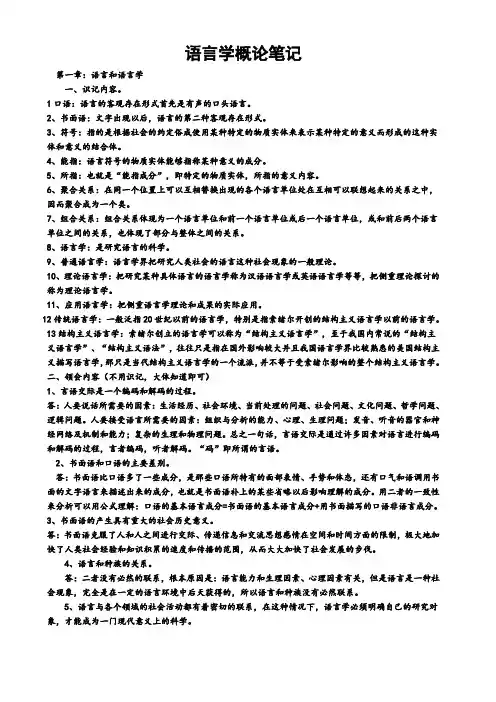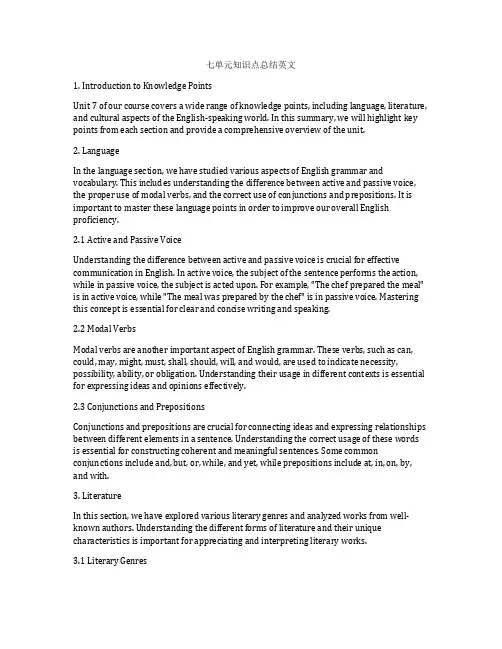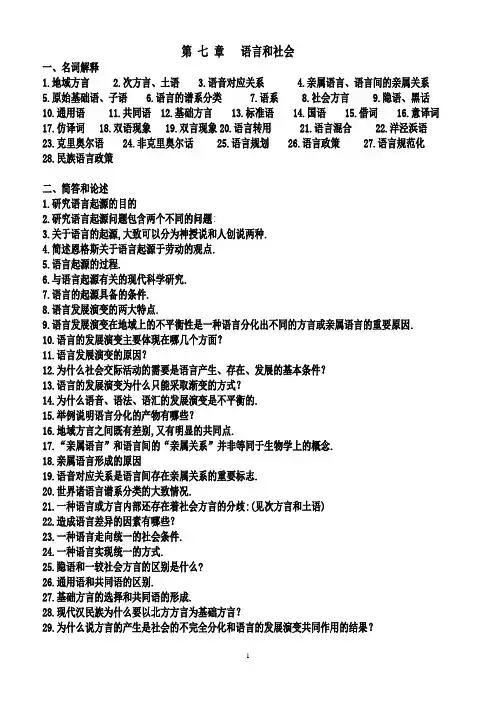英语语言学概论第七章笔记.
语言学概论:第七章__修辞学

识活动,而且具有美学价值。
2、从实用上看: 这有两个方面: (1)可以帮助我们提高语言表达能力,即运用于
说和写。 (2)可以帮助我们提高理解语言的能力,即运用
于听和读。
三、言语环境
言语环境指使用语言的环境,简称语境 (一)构成言语环境的因素 1、主观因素 2、客观因素 ①时间: ②地点、场合 ③民族习惯: ④对象:
(二)语境学是现代修辞学的基础
1、语境的主要作用有两点,解释功能和过滤功 能。
①解释功能: a 帮助听者推断出存在句子意义之外的信息,
(言外之意) b帮助听者从系统的意义推出具体的信息。 c 语境可以排除歧义,帮助听者获得准确信息。 d 语境可以补足省略 e 帮助听者从“不正常”逐步推断出正常的信息。
文艺
2、美国语言学家马丁·裘斯分为
语体
亲昵(intimate ) 随便 (casual) 商讨(consultative) 正式(formal) 冷淡(frozen)
3、英国伦敦学派
从语言使用者在使用语言过程中的目 的、方式及交际双方的关系和交际功能 等角度,把影响语体分类的情境分为三 种。
专业性:如科技、广告、新闻等
四、修辞手段和修辞方式
①词语选择 ②句式选择
五、语体 (一)修辞学与语体学的关系 目前有两种观点,一是语体学是修辞学的一门从
属学科。一是主张语体学是一门独立的学科, 从属于语言学下,与修辞学并列。 (二)语体的特点
(三)语体类型
1、苏联学者对功能语体的分类
口语体
科学体 语体 事务公文
书卷语体
政治
② 过滤功能
a 若一个句子只能表达语境已经提供的信息,一 般不宜说出。
语言学概论笔记自考(一到九章)

语言学概论笔记第一章:语言和语言学一、识记内容。
1口语:语言的客观存在形式首先是有声的口头语言。
2、书面语:文字出现以后,语言的第二种客观存在形式。
3、符号:指的是根据社会的约定俗成使用某种特定的物质实体来表示某种特定的意义而形成的这种实体和意义的结合体。
4、能指:语言符号的物质实体能够指称某种意义的成分。
5、所指:也就是“能指成分”,即特定的物质实体,所指的意义内容。
6、聚合关系:在同一个位置上可以互相替换出现的各个语言单位处在互相可以联想起来的关系之中,因而聚合成为一个类。
7、组合关系:组合关系体现为一个语言单位和前一个语言单位或后一个语言单位,或和前后两个语言单位之间的关系,也体现了部分与整体之间的关系。
8、语言学:是研究语言的科学。
9、普通语言学:语言学界把研究人类社会的语言这种社会现象的一般理论。
10、理论语言学:把研究某种具体语言的语言学称为汉语语言学或英语语言学等等,把侧重理论探讨的称为理论语言学。
11、应用语言学:把侧重语言学理论和成果的实际应用。
12传统语言学:一般泛指20世纪以前的语言学,特别是指索绪尔开创的结构主义语言学以前的语言学。
13结构主义语言学:索绪尔创立的语言学可以称为“结构主义语言学”,至于我国内常说的“结构主义语言学”、“结构主义语法”,往往只是指在国外影响较大并且我国语言学界比较熟悉的美国结构主义描写语言学,那只是当代结构主义语言学的一个流派,并不等于受索绪尔影响的整个结构主义语言学。
二、领会内容(不用识记,大体知道即可)1、言语交际是一个编码和解码的过程。
答:人要说话所需要的因素:生活经历、社会环境、当前处理的问题、社会问题、文化问题、哲学问题、逻辑问题。
人要接受语言所需要的因素:组织与分析的能力、心理、生理问题;发音、听音的器官和神经网络及机制和能力;复杂的生理和物理问题。
总之一句话,言语交际是通过许多因素对语言进行编码和解码的过程,言者编码,听者解码。
第七章-文字

第七章文字名词解释1.文字:文字是用来记录语言的书写符号体系。
2.表音文字:表音文字是书写符号记录语言中的语音的文字系统。
表音文字利用一套字母来拼写语言中的语词,因此又称拼音文字。
表音文字以语言的音节或者音位为书写单位,又分为音节文字和音位文字。
3.表意文字:表意文字是用书写符号记录词或语素的意义的文字体系。
早期的表意文字都是象形字。
有的表意文字用书写符号综合表示词或者语素的意义和声音。
和表音文字相比,表意文字能使人产生对于事物的客观形态的联想。
但表意文字也有缺点:一个字一个形,文字数量大;只表意不直接表音;结构复杂,笔画繁多,等等。
4.表音节文字:表音节文字是指书写符号记录语言中的音节的文字体系。
表音节文字的一个书写符号代表一个音节。
5.自源文字:自源文字是指独自创立和发展起来的文字体系。
这种文字从它的产生开始到发展都没有参照其它文字,其文字的形体和体系都是独创的。
现在世界上发现的几种最古老的文字,如汉字、古埃及文字、楔形文字,都是自源文字。
6.借源文字:借源文字是指借用参照其他文字的形体或者文字体系而建立起来的文字体系。
现在世界上的多数文字属于借源文字。
复习思考题。
1.文字的性质和作用是什么?性质:(一)文字是用来记录语言的书写符号体系。
①有了人类社会就有了口头语言,口语只能用于人们的口耳交际。
他要受到时空的限制,人们为了克服这种时空限制,创制了文字。
世界上各种文字都是用来记录语言的。
②文字是符号具备符号的特征,它能记录一个个语言单位。
但是符号不一定就是文字,文字可通过不同的组合构成另一个语言单位,而其他符号只能简单孤立的表达某种意义。
文字是语言的视觉符号,它按照一定的规律规则组合成书面语言。
③文字是一个系统。
系统,是指同类事物按照一定的关系组成的整体,其各个组成部分之间既互相联系又互相制约。
单个的孤立的个体是不能成为系统的。
文字是一套特定的书写符号,在文字的内部有着不同的层次的组成部分的结构规则,他们使文字成为一个有机的整体。
七单元知识点总结英文

七单元知识点总结英文1. Introduction to Knowledge PointsUnit 7 of our course covers a wide range of knowledge points, including language, literature, and cultural aspects of the English-speaking world. In this summary, we will highlight key points from each section and provide a comprehensive overview of the unit.2. LanguageIn the language section, we have studied various aspects of English grammar and vocabulary. This includes understanding the difference between active and passive voice, the proper use of modal verbs, and the correct use of conjunctions and prepositions. It is important to master these language points in order to improve our overall English proficiency.2.1 Active and Passive VoiceUnderstanding the difference between active and passive voice is crucial for effective communication in English. In active voice, the subject of the sentence performs the action, while in passive voice, the subject is acted upon. For example, "The chef prepared the meal" is in active voice, while "The meal was prepared by the chef" is in passive voice. Mastering this concept is essential for clear and concise writing and speaking.2.2 Modal VerbsModal verbs are another important aspect of English grammar. These verbs, such as can, could, may, might, must, shall, should, will, and would, are used to indicate necessity, possibility, ability, or obligation. Understanding their usage in different contexts is essential for expressing ideas and opinions effectively.2.3 Conjunctions and PrepositionsConjunctions and prepositions are crucial for connecting ideas and expressing relationships between different elements in a sentence. Understanding the correct usage of these words is essential for constructing coherent and meaningful sentences. Some common conjunctions include and, but, or, while, and yet, while prepositions include at, in, on, by, and with.3. LiteratureIn this section, we have explored various literary genres and analyzed works from well-known authors. Understanding the different forms of literature and their unique characteristics is important for appreciating and interpreting literary works.3.1 Literary GenresLiterary genres refer to different categories of literature, such as poetry, drama, fiction, and non-fiction. Each genre has its own distinct features and conventions, and understanding these can help us appreciate and analyze literary works more effectively.3.2 Analysis of Literary WorksWe have analyzed works from renowned authors, such as William Shakespeare, George Orwell, and Emily Dickinson. By examining their writing styles, themes, and symbolism, we have gained a deeper understanding of the literary techniques and devices used in their works. This has allowed us to develop critical thinking and analysis skills, which are essential for interpreting and evaluating literature.4. Cultural AspectsThe cultural aspects section of Unit 7 has provided us with insights into the customs, traditions, and social norms of English-speaking countries. Understanding these cultural aspects is important for effective communication and interaction with native English speakers.4.1 Customs and TraditionsWe have learned about various customs and traditions observed in English-speaking countries, including cultural festivals, social etiquettes, and traditional practices. Being aware of these customs and traditions can help us navigate social interactions and avoid cultural misunderstandings.4.2 Social NormsUnderstanding the social norms of English-speaking countries is crucial for effective communication and integration into their society. This includes understanding concepts such as personal space, politeness, and social hierarchy. By being aware of these norms, we can adapt our behavior and communication style to suit the cultural context.5. ConclusionUnit 7 has provided us with a comprehensive overview of language, literature, and cultural aspects of the English-speaking world. By mastering the knowledge points covered in this unit, we can improve our English proficiency, appreciate literary works, and navigate cultural interactions more effectively. It is important to continue practicing and applying these knowledge points in real-life situations to enhance our language skills and cultural competence.。
语言学概论:第七章__语言随着社会发展而发展

福建师范大学文学院
汉语被字句的产生到定型的过程
萌芽于战国末期,汉代慢慢使用开来:(未出现施事) 万乘之国,被围于赵。《战国策•齐策》 国一日被攻,虽欲事秦,不可得也。同上 信而见疑,忠而被谤。《史记• 屈原列传》 大约到了汉末,被字句才有了施事者,且施事者的位 置放在了被字和动词中间: 五月二十日,臣被尚书召问。 蔡邕《被收时表》 祢衡被魏武谪为鼓吏。 《世说新语•言语》 可见,汉语被字句的产生到定型的过程经历了三四百 年的时间。
福建师范大学文学院
语言学概论
古代汉语单音节词占优势,但是那时音位数量多 音位组合也多,词在语音形式上仍有区别。 机:居依切,平声,微韵,见母; 基:居之切,平声,之韵,见母; 交:古肴切,平声,肴韵,见母; 娇:举乔切,平声,宵韵,见母; 尖:子廉切,平声,盐韵,见母; 娘:古闲切,平声,山韵,见母。
语言学概论
福建师范大学文学院
各南方方言的产生时期
吴语的最早源头可到先周时代,以太伯和仲雍为 代表的北方移民,南徙到当时较落后的江南地区 (相当于今天苏南无锡、镇江一带)。吴语作为 一种独立的方言在以《世说新语》为代表的南北 朝时代的文献中已经有非常明确的记载。 由于北方移民带来的北方话的影响,较古老的吴 语特征在从北向南递减的,而最古老的吴语特征 则保留在今天的闽语里。或者说闽语的底子是古 吴语。
语言学概论
福建师范大学文学院
语言符号是音义结合,符号之间必须保持有效的 区别,如果这种区别性受到干扰、破坏,语言系 统将会发生变化: 1.藏语:浊音清化、前缀辅音脱落→声调产生。 2.汉语:单音节→音节结构复杂→音节结构简化→ 多音节→轻音、儿化、词缀。 古英语、古法语有复杂的变格、变位系统,现已 大大简化,这种语法面貌的改变是语音弱化和脱 落的结果。是由语音演变引起的连锁反应。
语言学概论 第七章 语言和社会 自学笔记

第七章语言和社会一、名词解释1.地域方言2.次方言、土语3.语音对应关系4.亲属语言、语言间的亲属关系5.原始基础语、子语6.语言的谱系分类7.语系8.社会方言9.隐语、黑话10.通用语 11.共同语 12.基础方言 13.标准语 14.国语 15.借词 16.意译词17.仿译词 18.双语现象 19.双言现象20.语言转用 21.语言混合 22.洋泾浜语23.克里奥尔语 24.非克里奥尔话 25.语言规划 26.语言政策 27.语言规范化28.民族语言政策二、简答和论述1.研究语言起源的目的2.研究语言起源问题包含两个不同的问题:3.关于语言的起源,大致可以分为神授说和人创说两种.4.简述恩格斯关于语言起源于劳动的观点.5.语言起源的过程.6.与语言起源有关的现代科学研究.7.语言的起源具备的条件.8.语言发展演变的两大特点.9.语言发展演变在地域上的不平衡性是一种语言分化出不同的方言或亲属语言的重要原因.10.语言的发展演变主要体现在哪几个方面?11.语言发展演变的原因?12.为什么社会交际活动的需要是语言产生、存在、发展的基本条件?13.语言的发展演变为什么只能采取渐变的方式?14.为什么语音、语法、语汇的发展演变是不平衡的.15.举例说明语言分化的产物有哪些?16.地域方言之间既有差别,又有明显的共同点.17.“亲属语言”和语言间的“亲属关系”并非等同于生物学上的概念.18.亲属语言形成的原因19.语音对应关系是语言间存在亲属关系的重要标志.20.世界诸语言谱系分类的大致情况.21.一种语言或方言内部还存在着社会方言的分歧:(见次方言和土语)22.造成语言差异的因素有哪些?23.一种语言走向统一的社会条件.24.一种语言实现统一的方式.25.隐语和一较社会方言的区别是什么?26.通用语和共同语的区别.27.基础方言的选择和共同语的形成.28.现代汉民族为什么要以北方方言为基础方言?29.为什么说方言的产生是社会的不完全分化和语言的发展演变共同作用的结果?30. 为什么说语音差异是方言分区的主要依据?31.举例说明方言间在词汇和词义上的两点差异。
语言学概论 第七章语言演变与语言分化
Ø语言风格变体的存在增加了社会方言的丰富性 和多样性。
(二)地域方言
• 地域方言,通常指方言,是一种语言在不同地区的变体, 也是全民语言在不同地域的变体,是统一的全民语言的 分支。
• 地域方言的差异主要表现在语音、词汇、语法各个方面, 尤以语音差别最突出,汉语普通话和地域方言最大的差 别是在语音上。
Ø听得懂、听不懂不能作为划分方言的标准。
• 如斯拉夫语族的国家,操俄语、乌克兰语、白俄 罗斯语、波兰语、塞尔维亚语的人相互间可以通 话,但却是不同的语言。
• 汉语的北方方言与吴、湘、赣、客、粤、闽方言 之间的差别比较大,相互间很难通话,但却是同 一种语言的不同方言。
5. 确定是语言还是方言的标准:
• 6.商阜片:商丘市区、睢县、鹿邑等,f和sh不分,如“喝 水”称作“喝fei”。
• 7.信蚌片:信阳市区、淮滨、罗山、安徽蚌埠,“俺爸俺 妈”听起来像“阿爸阿妈”,且无翘舌音。
• 8.汾河片:三门峡市、渑池、灵宝等,如“脖子”叫“婆航”、 “膝盖”叫“哭气盖”。
3.方言岛
• 方言岛,是语言学的一个术语,由于历史上大规 模移民,使外来的方言势力占据了原来某方言区, 形成被原方言区包围着的独立的方言孤岛。 • 如美国的唐人街就是英语包围汉语的方言岛,四 川官话区域中的湖南话小区,就是方言岛。
Ø交际要求语言保持稳定的状态,不允许一下子 发生大的变化。所以语言的演变只能采取渐变的 方式,不允许突变。 如斯大林所说:“语言从旧质过渡到新质不是经 过爆发,不是经过消亡现存的语言和创造新的语 言,而是通过新质要素的逐渐积累,也就是经过 旧质要素的逐渐死亡来实现的。”
英语语言学概论第七章笔记.
Chapter 7 Historical Linguistics 历史语言学1. The purpose and significance of the historical study of language 研究语言变化的目的和意义The historical study of language is of great importance to our understanding of human languagesand human linguistic competence.Researches in historical linguistics shed light on prehistoric development in the evolution oflanguage and the connections of earlier and later variants of the same language, and providevaluable insights into the kinship patterns of different languages.The historical study of language also enables us to determine how non-linguistic factors, such associal, cultural and psychological factors, interact over time to trigger linguistic change.研究语言变化对于理解人类语言和人类的语言能力极其重要。
历史语言学的研究成果揭示语言变化的史前发展和同一语言早期和后期变体自己的联系,为不同语言的亲缘关系提供线索。
历史语言学的研究还可以使我们对非语言的因素,如社会文化和心理因素等在语言变化过程中所起的作用有更深的认识。
语言学概论,章节测试 第七章
第七章语言的书写符号——文字一、单项选择题1.下列关于文字和语言关系说法不正确的一项是A.文字的特点和语言的特点没有任何联系B.文字不能等同于语言C.文字是语言的书写符号系统D.同一语言可以采用不同的书写符号系统【解析】A 本题考查文字的相关知识。
文字是语言的书写符号系统。
文字是在语言的基础上产生的,因此文字的特点和语言的特点是有一定联系的。
2.不能再分解的字符是A.笔画B.复合字符C.单纯字符D.意符【解析】C 单纯字符是不能再分解的字符。
3.下列关于声符来源的表述中,正确的一项是A.声符是从笔画发展而来的B.声符是从记号发展而来的C.声符是从声旁转化而来的D.声符是从意符转化而来的【解析】D 本题考查声符的相关知识。
声符是表音的字符,但是语音没法用图形来表示,因此声符最初都是由已有的意符转化而来的。
4.下列文字中属于表音文字的是A.苏美尔文字B.汉字C.日语“假名”D.古埃及圣书字【解析】C 日语“假名”属于表音文字。
5.文字的演变经历了一个漫长和复杂的过程,它的最初形态是A.象形字符B.图形契刻符号C.表意字符D.表音字符【解析】B 本题考查文字的演变过程。
文字从最初的图形契刻符号,演变成象形字符,再到形成表意字符,再到出现表音字符,表音字符中又从表音节的字符到表音位的字符,经历了一个相当漫长和复杂的过程。
6.最早的表音文字是A.拉丁文字B.腓尼基文字C.古希腊文字D.古埃及文字【解析】B 本题考查最早的表音文字。
腓尼基人借用了楔形文字和古埃及文字,最终形成了一种最早的字母式表音文字,即腓尼基文字。
7.下列文字中,不属于自源文字的是A.古埃及文字B.古汉字C.古希腊文字D.古代楔形文字【解析】C 本题考查自源文字的相关知识。
古希腊文字是在借用腓尼基文字的基础上产生和发展起来的,因此属于他源文字。
8.已知的自源文字都是A.音节文字B.表音文字C.音素文字D.意音文字【解析】D 本题考查自源文字的相关知识。
语言学概论第七章语言的起源与发展
一,语言的起源语言的起源的两层意思:⑴具体语言的形成⑵人类语言的产生㈠恩格斯关于语言起源的理论⒈著作:《劳动在从猿到人转变过程中的作用》⒉基本观点:劳动决定了产生语言的需要和可能,劳动创造了语言⒊劳动决定产生语言的可能的原因:⑴劳动促进人类发音器官的演化,使原始人能逐渐发出许多清晰的声音,为语言符号提供了必要的声音材料。
⑵劳动促进人类思维的发展,使语言所必需的意义要素得以形成。
㈡关于语言起源的另外几种学说⒈手势说(gesture theory)代表人物:苏联马尔⒉摹声说(onomatopoeic theory)又称:汪汪说或布谷说代表人物:德国保罗⒊感叹说(exclaimation theory)又称:呸呸说代表人物:古希腊伊壁鸠鲁中国刘师培黎锦熙(叹词起源论)⒋社会契约说(social charter theory)也叫:社会约定论代表人物:古希腊迭奥多尔·西齐列斯基《世界史》:认为互相商定每一个事物记号法国启蒙思想家卢梭⒌劳动呼声说(labour shout theory)又称:咳唷说代表人物:法国语言学家诺瓦雷㈢探索语言起源的新途径⒈人与猿类的比较⒉儿童学说话⒊失语症:美国语言学家雅可布逊(R·Jackobson)二,语言发展的一般情况㈠马克思关于语言发展的理论⒈语言的发展离不开社会的发展,语言作为一种社会现象在人们使用语言进行交际的过程中得到发展。
⑴语言是一种社会现象,它不可能脱离社会和作为社会动物的人而存在和发展⑵语言是在发挥它的交际只能,也就是被人们的实际使用的过程中得到发展⒉语言是不断发展的,但语言各要素的发展是不平衡的。
斯大林指出:①语言是随社会的产生和发展而产生发展的。
语言随着社会的死亡而死亡。
②语言中最主要的东西的它的语法构造和基本词汇。
⒊不同语言可能具有某些共同的规律,但构成语言发展的主要是差别。
⑴不同语言具有某些共同的规律和规定。
⑵各种语言之间存在差别。
- 1、下载文档前请自行甄别文档内容的完整性,平台不提供额外的编辑、内容补充、找答案等附加服务。
- 2、"仅部分预览"的文档,不可在线预览部分如存在完整性等问题,可反馈申请退款(可完整预览的文档不适用该条件!)。
- 3、如文档侵犯您的权益,请联系客服反馈,我们会尽快为您处理(人工客服工作时间:9:00-18:30)。
Chapter 7 Historical Linguistics 历史语言学1.The purpose and significance of the historical study of language研究语言变化的目的和意义The historical study of language is of great importance to our understanding of human languages and human linguistic competence.Researches in historical linguistics shed light on prehistoric development in the evolution of language and the connections of earlier and later variants of the same language, and provide valuable insights into the kinship patterns of different languages.The historical study of language also enables us to determine how non-linguistic factors, such as social, cultural and psychological factors, interact over time to trigger linguistic change.研究语言变化对于理解人类语言和人类的语言能力极其重要。
历史语言学的研究成果揭示语言变化的史前发展和同一语言早期和后期变体自己的联系,为不同语言的亲缘关系提供线索。
历史语言学的研究还可以使我们对非语言的因素,如社会文化和心理因素等在语言变化过程中所起的作用有更深的认识。
2.The nature of language change语言变化的本质All living languages change with time. Unless a language is no longer spoken by the general public of a society, such as Latin, its change is inevitable. As a general rule, language change is universal, continuous and, to a considerable degree, regular and systematic. Language change is extensive, taking place in virtually all aspects of the grammar.Although language change is universal, inevitable, and in some cases, vigorous, it is never an overnight occurrence.Language development may be regarded as linguistic evolution from one stage to another.所有尚在使用的语言都随着时间的变化而变化。
语言的变化是不可避免的。
语言变化是普遍的、连续的,在一定程度上也是规则的和系统的。
语言变化涉及语法系统的各大组成部分。
在语言演变过程中,词汇和语法规则有的消亡了,有的诞生了,有的是外借的,有的则转化了其意义或功能。
尽管语言变化是普遍的,必然的,有时甚至是显著的,但语言的变化是一个缓慢的渐变过程,其变化是同代人所不易察觉的。
语言的发展可以看作是语言从一个阶段到另一个阶段的演化过程。
3.Major periods in the history of English英语历史发展的主要阶段a)Old English (450-1100) 古英语阶段b)Middle English (1100-1500) 中古英语阶段c)Modern English (1500-今) 现代英语阶段Most Modern English speakers find Middle English only partially comprehensible, and Old English simply unintelligible, just like a foreign language hardly recognizable as the native language they speak.大多数现代英语的使用者发现,对于他们来说,中古英语只能部分地被理解,古英语则如外语一般,简直不可理解。
Old English dates back to the mid-fifth century when Anglo-Saxons invaded the British Isles from northern Europe.Middle English began with the arrival of the Norman French invaders in England. Middle English had been deeply influenced by Norman French in vocabulary and grammar.Modern English is separated with Middle English with European renaissance movement.古英语源自欧洲大陆的盎格鲁撒克逊民族所操的语言。
中古英语深受诺曼底占领者所操的法语的影响。
词汇和语法等均受其影响。
现代英语是英语自身发展和欧洲文艺复兴运动渗透结合的产物,很多词汇是外来语。
As British influence reached other continents, the “British Empire” established English-speaking colonies in many parts of the world. English is now the native language in the United States, Canada, Australia and New Zealand.英帝国的兴起及其移民化过程的成功使现代英语的使用遍布全球。
以现代英语为母语的国家包括英国、美国、加拿大、澳大利亚和新西兰等。
4.Linguistic change in English英语语言系统的变化Language change is essentially a matter of change in the grammar. We refer to the change in the grammar of a language as linguistic change. Linguistic change occurs in all components of the grammar, including changes in the sound, morphological, syntactic, lexical and semantic systems. 语言变化实质上是语法变化。
我们把一种语言的语法变化称为语言变化。
语言变化包括语音系统、形态系统、句法系统、词汇系统和语义系统等部分的变化。
a)sound change 语音变化●V owel sound change 元音变化The change occurred at the end of the Middle English period, approximately 1400-1600. These changes led to one of the major discrepancies between the phonemic representations of words and morphemes, that is, between the pronunciation and the spelling system of Modern English. Known as the Great Vowel Shift in the history of English, these changes involve seven long, or tense, vowels. Refer to P132 of the test book for examples.元音变化出现在中古英语后期,大约在1400到1600年之间。
这些变化使一些单词的音位表达和词素之间出现了很大的不一致。
这些变化在英语史上被称为元音大变位,涉及七个长元音,或紧元音。
实例见书本132页。
●Sound loss 语音消失Not only did types of vowel sounds change, but some sounds simply disappeared from the general pronunciation of English.不仅数种元音发生了变化,而且一些语音还从英语的整个发音体系中消失了。
实例:1》古英语中/x/ 在现代英语中已不存在。
如:古英语nicht (night) 读做/nixt/,而现代英语读做/nait/2》古英语和中古英语中有/kn/,都发音,在现代英语中/k/不发音了。
如:knight/knee 在古英语中字母k是发音的,而在现代英语中不发音3》古英语中有一类名词的复数形式不是在词尾加/s/音,而是加/i/这个音,现在没有了。
如:goose的复数形式在古英语中的发音是/go:si/4》现代英语中出现了位于词尾的元音音段的省略现象,称为词尾音脱落。
如:name/love在古英语中发音为/na:ma:/和/lufu/,在中古英语中发音为/na:mə/和/luvə/,而在现代英语中的发音为/neim/和/lΛv/5》词尾音脱落还影响了某些词的拼写。
如:古英语单词helpe随着词尾音的消失,在中古英语和现代英语中拼写成了help●Sound addition 语音增加While some sounds were lost in the course of the historical development of English, other sounds were added. Sound addition includes the gain or insertion of a sound. A change that involves the insertion of a consonant or vowel sound to the middle of a word is known as epenthesis. Refer to P134 of the text book for examples.英语在发展过程中消失了一些语音,但也增加了一些语音。
